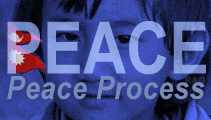 |
| Nepal Elections |
| Election
2008 |
|
 |
|
Constituent
Assembly Election 2008: Results |
|
| First-past-the-post
(FPTP) |
Proportional
Representation (PR) |
top
|
Constituent
Assembly Election 2008 - Results |
 |
 |
|
First-Past-the-Post
(FPTP) & Proportional Representation (PR) - 575 seats |
 |
top
| Constituent
Assembly Election 2008: Information |
 |
11
April 2008
 UNMIN First
post-Election Statement UNMIN First
post-Election Statement
11
April 2008
Nepal
's Election Commission (EC) has declared that re-polling will be required
in at least 60 polling stations, from over 20,000 stations, across the
country. Stations affected are from 16 constituencies in ten districts.
The
Chief Election Commissioner has stated after the close of polls that on
its current information the Election Commission's initial estimate is of a
60 per cent voter turnout, and that it has cancelled polls in 33
out of the more than 20,000 polling centres. 95% of all votes cast
were valid.
Results
for all the 240 constituencies are expected over the next 10 days.
12
April 2008
The
United Nations High Commissioner for Human Rights Louise Arbour congratulated
the people of Nepal on Thursday's elections for a Constituent Assembly,
which she described as a crucial advance in the country's historic transition,
and one that should have a very positive long-term impact on the human
rights of its citizens.
'Elections
for a Constituent Assembly that will be responsible for drafting a new
constitution are a major stride towards a new future in Nepal in which
the rights of all people - including historically marginalized communities
- are respected,' Arbour said. The High Commissioner particularly welcomed
the reportedly large and enthusiastic participation of women in the election.
'I
congratulate the authorities for their success so far in holding a largely
peaceful election process despite the difficult circumstances. And I trust
that all the political parties in Nepal will accept the decision of the
electors, whatever it may be.'
The
High Commissioner said she was deeply saddened by a number of deaths that
occurred during the run up to the election and on Election Day itself.
She extended her condolences to the families concerned, and encouraged
the Government to act quickly to set up an independent inquiry to investigate
the circumstances surrounding the deaths.
17
April 2008
Nepal's
Election Commission announced results in the first-past-the-post (FPTP) race
had been declared in 220 constituencies, including some where re-polling
had taken place. Votes are still being counted in 7 constituencies
Meanwhile
in the proportional representation (PR) race results had been declared
in 143 constituencies and counting is underway in 82. Re-polling was conducted
in 9 constituencies today, while votes were counted from re-polling held
earlier this week in 7 others. The EC expects that re-polling in all 21
constituencies (98 polling stations, 12 districts) will be completed by
Saturday 19 April 2008.
23
April 2008
The
EC published in a press statement a range of facts on the final results
for the first-past-the-post vote. The total number of candidates for FPTP
was 3,946. Among those, 3,157 candidates (80 percent) did not receive 10
per cent of the total number of votes cast in their respective constituencies,
and their deposits shall be forfeited. The most number of votes were cast
in Dolpa, Humla (in the did-western mountains), 80 percent, and Kathmandu-10,
at 77 per cent. The least number of votes were cast in Manang (in the western
mountains), at 40 per cent. Among the elected candidates, the oldest were:
female - Suprabha Ghimire (66 years, Nepali Congress, Kathmandu-4); male
- Kul Bahadur Gurung (73 years, Nepali Congress, Ilam-3). And the youngest
elected candidates were: female - Durga Kumari BK (26 years, CPN (Maoist),
Kaski-4); male - Abhishek Pratap Sah (25 years,MPRF, Kapilvastu-5).
Source:
UNMIN
25
April 2008
Nepal's
Election Commission announced the number of seats allocated to political
parties after tabulation of the proportional representation vote. At an
interaction event at the Commission's Kathmandu headquarters, all five
Election Commissioners attended to brief party representatives, members
of election observer groups and the media on the election results and the
process parties must now undergo to select candidates for the PR seats.
The
EC announced that 11,146,540 votes were cast under the PR system, with
10,739,078 valid votes. This represented more than 63 percent turnout.
A
total of 25 parties shared the 335 PR seats.
Chief
Election Commissioner Bhoj Raj Pokharel announced that the Communist Party
of Nepal (Maoist) won 100 seats under the PR system, while Nepali Congress
and Communist Party of Nepal (United Marxist-Leninist) received 73 and
70 seats respectively. The fourth and fifth largest share of seats went
to two Terai-based parties - Madhesi Janaadhikar Forum (22) and Tarai Madhes
Loktantrik Party (11).
Source:
UNMIN
10
May 2008
Nepal's
Election Commission announced the final list of candidates nominated to
the Constituent Assembly through the proportional representation (PR) race.
These candidates will occupy 335 of 601 seats in the assembly. Of the remaining
seats, 240 will be filled by candidates elected directly through the first-past-the-post
(FPTP) system and 26 will be filled by members appointed by the Council
of Ministers.
A
total of 25 political parties shared the PR seats, with the Communist Party
of Nepal (Maoist) securing the largest number, 100, followed by the Nepali
Congress with 73 and the Communist Party of Nepal (United Marxist-Leninist)
with 70. The Madhesi People's Rights Forum and the Terai Madhes Democratic
Party secured 22 and 11 seats respectively.
| Constituent
Assembly Election 2008: Top party leaders elected |
 |
| Constituency |
Name |
Party |
Gender |
| Kathmandu |
Hisila
Yami (Bhattarai) |
Communist
Party of Nepal (Maoists) |
F |
| Kathmandu |
Pushpa
Kamal Dahal (Prachanda) |
Communist
Party of Nepal (Maoists) |
M |
| Gorkha |
Baburam
Bhattrai |
Communist
Party of Nepal (Maoists) |
M |
| Rautahat |
Madhav
Kumar Nepal |
Communist
Party of Nepal (U.M.L.) |
M |
top
| Links |
 |
 |
 |
External
Links |
|



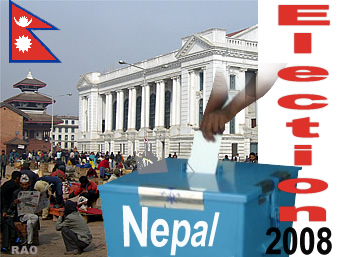
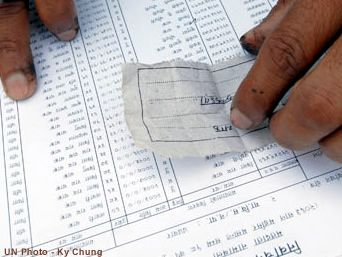
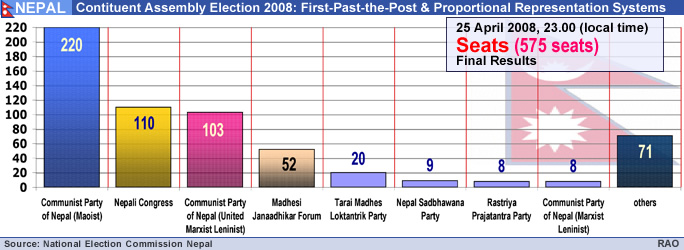
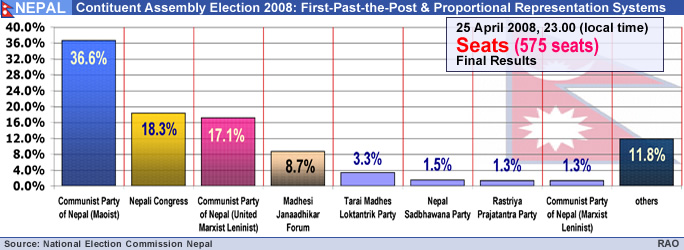
![]() UNMIN First
post-Election Statement
UNMIN First
post-Election Statement
